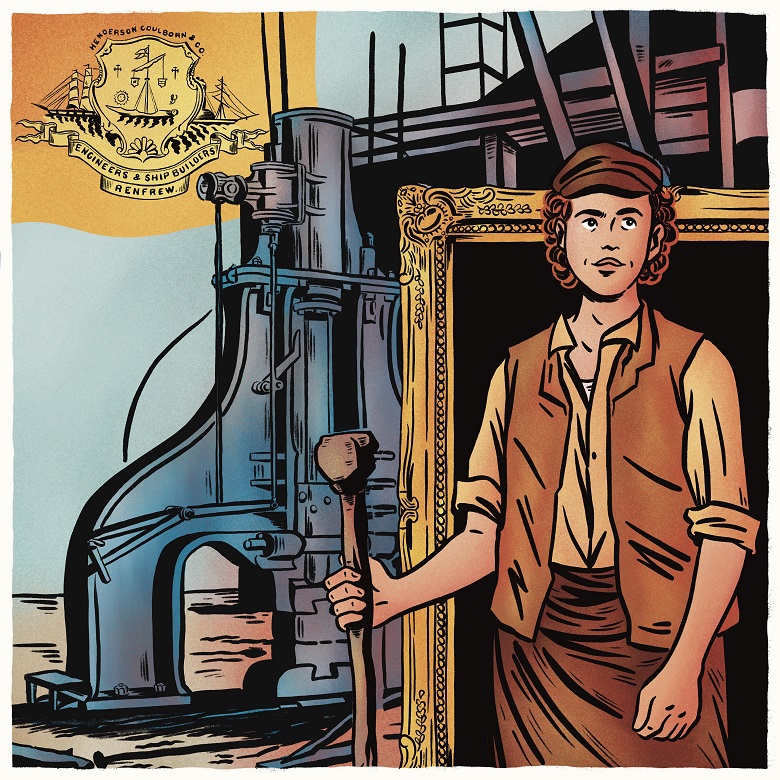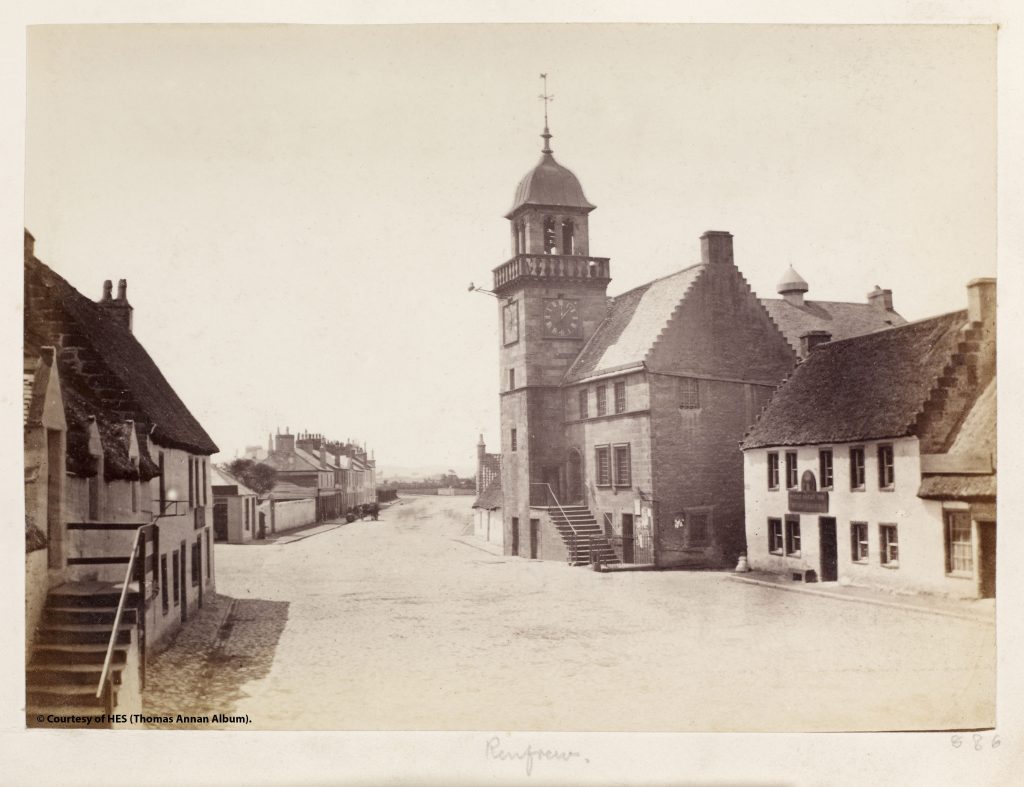When John Campbell fell ill with smallpox in a Renfrew lodging house in 1871, unexpected events were to follow.
The roots of the crisis lay in Kirknewton, a village a little over 10 miles outside of Edinburgh. John had lived there in 1869, marrying local woman Mary Ann McKenna. After just six months, their relationship had faltered. John left his wife and moved to Renfrew, motivated by a desire to start life afresh. Married life had not been what he, or his wife, had expected.
Some months after John left, Mary Ann had been hauled before the parish authorities for failing to disclose her husband’s ‘desertion’. She was pregnant, had been left to care for the couple’s two other children, and was reliant on poor relief.
It was at this stage that Mary Ann “raised the cry that her husband was a woman”, according to newspaper reports of the time. What Mary Ann’s evidence suggests is that she was unaware that John had not been assigned male at birth when she married him.

John Campbell worked in the forge at Henderson, Coulborn and Co., a shipbuilding firm in Renfrew. Illustration by Jules Scheele.
Gender non-conformity in history
History doesn’t offer us an opportunity to ask questions of the long deceased. We can’t explore their motivations, and we should be careful about applying 21st century definitions or labels.
However, it is important to tell the stories of people who have adopted genders other than that which society assigned them. The details of their lives may resonate for trans and genderqueer identities today. Their stories pave the way for genderqueer people today.
I’ll be referring to the subject of this blog as John and using he/him as, from the records we have of him, we know that is how he chose to live his life after entering adulthood until history loses track of him.
Johnnie Campbell
From the news stories, it seems that John’s path through life was influenced in part by his landlords, Mr and Mrs Early.
John was living with them in Renfrew at the time of his discovery. However, Mrs Early confirmed that they had known him for five years. She had known him as a man that whole time. They had met when John was working alongside her husband, Thomas Early, as a farm labourer near Tranent.
Following higher wages, John then found construction work on the new railway line between Dalkeith and Ormiston.
Mrs Early remembered that at this time John shared a room with a male lodger. He also had a relationship with a young woman from the Highlands called Kate Martin. The North British Daily Mail recounted that John “conducted [himself] towards the young woman with all the usual ardour of an affectionate beau.”
Life in Kirknewton
We don’t know what took John to Kirknewton. Perhaps it was work, as we know he was working as a labourer at a shale pit there. What we do know is that he married Mary Ann McKenna there in December 1869 and lived with her in East Calder until they parted ways six months later in May 1870.

Kirknewton Main Street pictured in around 1990. © Courtesy of HES (Richard Jacques Collection).
Mary Ann already had two children out of wedlock when John married her. It was reported in the press that during the later investigation John had asserted that “Mary Ann knew that I was a woman; it was to make us more comfortable that we lived together”.
Life in Renfrew
Escaping his unhappy marriage, John headed to Renfrew. It seems likely that his friendship with the Earlys drew him to the village. He was always eager to help out Mrs Early with household tasks and became a favourite resident at Pinkerton Lane. Indeed, a rumour had circulated that John and Mrs Early were having an affair.

General view of Renfrew as it would have looked in around 1880.
John found work in the forge at Henderson, Coulborn and Co., a local shipbuilding firm. He seemed to have settled into life in Renfrew.
When John developed a sudden illness, this caused considerable worry for Mrs Early. So much so, that she contacted the local doctor despite John’s protestations. According to newspaper accounts, the doctor diagnosed smallpox and was insistent that the patient must be sent to Paisley Infirmary:
Seeing that the medical gentleman was so determined, the patient wished to be clothed and leave town. This raised the curiosity of Dr Allison, and he at once put the question, ‘Was it because of sex.’ The reply was in the affirmative. […] The doctor appraised the landlady, Mrs Early, of his discovery and to her surprise informed her that she must get women’s clothes in which to dress her lodger, so that she might be admitted to the Paisley Infirmary as none other than Marie Campbell.”

The location of the old Paisley Infirmary on Bridge Street. It was surrounded by buildings that belonged to Paisley’s industrial and textile heritage. Reproduced with the permission of the National Library of Scotland’ (Attribution 4.0 International (CC BY 4.0)
Getting to the truth
Word soon reached Kirknewton of this ‘extraordinary fraud’. The parish authorities, who had been initially dismissive of Mary Ann’s claim, sent a delegation to the hospital in Paisley. Their mission was to confirm whether John was the biological father of the child.
Amongst those who attended was John and Mary Ann’s best man, Will Waddell. On seeing his guest arrive, John, now resident in a female ward exclaimed: “Is that you Will Waddell? How’s the wife an’ bairns?”
When questioned, John claimed Mary Ann had known all about the ‘disguise’ and this was an attempt to deflect gossip. Mary Ann however, claimed she had married in good faith, and the revelation had only occurred after the wedding.
Whatever the truth, John Campbell, born Marie Campbell, had embarked on an extraordinary career from an early age. Press accounts from the time provided two theories as to why John chose to live the life he did, allegedly according to John himself. It was reported that John’s older brother, on his deathbed, had advised him to make his way in life as a man, for a woman’s lot was not a happy one.
Another reason that John apparently gave was that he had experienced abuse at a young age and for his own state of mind and security he attired and lived as a man. In cases like this, the people involved often seem to present versions of the truth they felt that wider society might accept.
It’s impossible to determine exactly how John felt about his gender or sexuality, but it certainly seems that he felt more comfortable and authentic living as a man.
Desperately seeking John Campbell
Most of what we know about John Campbell is gleaned from the newspapers of the time, which were fascinated by the story. They contain many clues, but we don’t know who their sources were. Much of the information is likely second or third hand and should be treated with caution.
What do we know of John’s life before or after these drastic revelations? The truth is, very little. We don’t know exactly when or where John was born. We don’t know for sure what happened to him afterwards. He was prosecuted for misusing the legal institution of marriage and for fraudulently registering a marriage and that is where John Campbell’s story ends in the records. The National Records of Scotland have done some important work on trying to trace John Campbell through official records.
However, since I first delved into John’s story, interesting links and theories have been discovered – or rediscovered. One such theory is that John Campbell emigrated to America and reinvented himself as Murray Hall, a New York politician.
Havelock Ellis, a pioneer of the scientific study of human sexuality, included a case study of Murray Hall in the 1915 edition of his work Sexual Inversion. The account he gives of Murray Hall’s origins share some commonalities with what we know about John Campbell’s story. However, we don’t know Ellis’ source for this information. It’s possible that he patched the stories of two separate individuals together. Speaking of Murray Hall, Ellis wrote:
[His] real name was Mary Anderson, and [he] was born in Govan, in Scotland. Early left an orphan, on the death of [his] only brother [he] put on his clothes and went to Edinburgh, working as a man. [His] secret was discovered during an illness, and [he] finally went to America.”
A respected man
Despite the shock that the revelations brought to those who knew John Campbell, few had scornful words. His former colleagues in Renfrew started a subscription to support him stating that “a more kindly and obliging worker never was engaged in the yard”. The Earlys, particularly Mrs Early, thought of John with such fondness that she could not condemn him.
John faced charges under the Registration Act for fraudulently contracting a marriage; Mary Ann returned to West Lothian; and life in Pinkerton Lane, Renfrew returned to normal.
Yet, most people who knew John Campbell continued to remember fondly, the young man who had touched their lives.
Explore more LGBTQI+ History
Read more LGBTQI+ history on our blog.
Watch as Jeff Meek and Amy Tooth Murphy discuss the unheard histories, triumphs and tragedies of Scotland’s LGBTQI+ past in this livestream from 2021.

